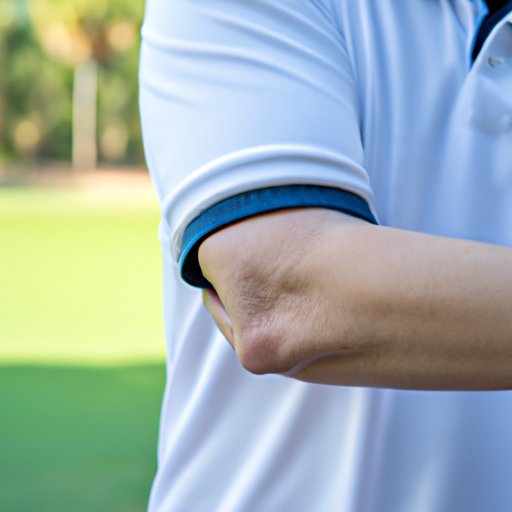Introduction
Golf elbow, also known as medial epicondylitis, is an overuse injury that can cause pain and discomfort in the elbow joint. It’s common among amateur and professional golfers, but it can also affect those who participate in other sports and activities. This article will explore the causes and symptoms of golf elbow, treatment options, stretching exercises and diet tips to help manage the pain and discomfort.

Exploring the Causes and Symptoms of Golf Elbow
Golf elbow is caused by repetitive strain on the tendons and muscles in the forearm, which can lead to inflammation and microtears in the tendon fibers. This type of overuse injury can be caused by poor swing mechanics or excessive use of the arm when playing golf. Other activities that can contribute to golf elbow include racket sports, throwing sports, weightlifting, typing and using tools.
Common symptoms of golf elbow include pain and tenderness on the inside of the elbow, swelling, weakness in the forearm and wrist, and reduced range of motion. The pain may radiate down the arm, and it can be worse when making a fist or gripping objects. Some people may experience numbness or tingling in the fingers.
Treatments for Golf Elbow: What Works and What Doesn’t
The best way to treat golf elbow is to rest the affected arm and avoid activities that aggravate the pain. Ice can also be used to reduce inflammation, and over-the-counter medications such as ibuprofen can help relieve pain and swelling. Physical therapy can also be beneficial, as it can help strengthen the muscles and tendons in the forearm and improve flexibility.
Corticosteroid injections are sometimes used to reduce inflammation and pain, although they should be used sparingly due to the risk of side effects. Platelet-rich plasma (PRP) therapy may also be recommended, as it can help speed up the healing process by stimulating tissue regeneration. In some cases, surgery may be necessary to repair any damaged tendons or ligaments.
Understanding How Golf Elbow Impacts Performance on the Course
Golf elbow can have a significant impact on performance on the course. People with this condition may experience a loss of strength and endurance in their arm, making it difficult to maintain a consistent grip on their club. They may also experience difficulty swinging the club, as the pain and discomfort can make it hard to generate power and control the club head.

A Guide to Stretching Exercises for Golf Elbow Prevention
Stretching exercises are important for preventing golf elbow, as they can help increase flexibility in the arm and reduce the risk of injury. Forearm stretches, wrist stretches and shoulder stretches can all be beneficial for reducing tension in the muscles and tendons. It’s important to stretch regularly and avoid overstretching, as this can put unnecessary strain on the muscles and tendons.
The Pros and Cons of Surgery for Golf Elbow
Surgery is sometimes recommended for golf elbow, but it’s important to understand the risks and benefits before deciding whether or not to proceed. The main benefit of surgery is that it can repair any damaged tendons or ligaments, which can reduce pain and improve function. However, there are risks associated with any surgical procedure, including infection, nerve damage and scarring.

Healing the Pain of Golf Elbow Through Diet and Nutrition
Diet and nutrition play an important role in managing golf elbow pain and discomfort. Eating anti-inflammatory foods such as fruits, vegetables, fish and nuts can help reduce inflammation and promote healing. Certain supplements can also be beneficial, including glucosamine, omega-3 fatty acids and vitamin C.
Top Tips for Managing Golf Elbow Pain and Discomfort
In addition to diet and stretching exercises, there are a few other things you can do to manage golf elbow pain and discomfort. Wearing a compression sleeve can help reduce inflammation and support the elbow joint. It’s also important to seek professional help if the pain persists, as this can help determine the best course of action. Avoiding certain activities, practicing good posture and listening to your body can also be beneficial.
Conclusion
Golf elbow is a common overuse injury that can cause pain and discomfort in the elbow joint. It’s important to understand the causes and symptoms of golf elbow, as well as the different treatment options, stretching exercises and diet tips to help manage the pain and discomfort. With proper prevention and treatment, golfers can continue to enjoy their favorite sport without having to worry about the pain of golf elbow.


